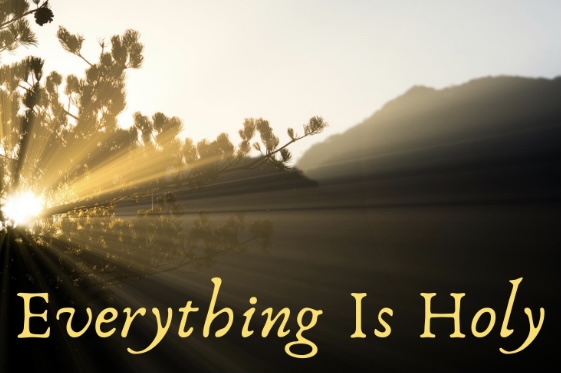Weekly Bible Devotional
“Everything Is Holy: Our Doubts”
April 18, 2021
Scripture for Sunday: John 20:19-29
When it was evening on that day, the first day of the week, and the doors of the house where the disciples had met were locked for fear of the Jews, Jesus came and stood among them and said, “Peace be with you.” 20After he said this, he showed them his hands and his side. Then the disciples rejoiced when they saw the Lord. 21Jesus said to them again, “Peace be with you. As the Father has sent me, so I send you.” 22When he had said this, he breathed on them and said to them, “Receive the Holy Spirit. 23If you forgive the sins of any, they are forgiven them; if you retain the sins of any, they are retained.” 24But Thomas (who was called the Twin), one of the twelve, was not with them when Jesus came. 25So the other disciples told him, “We have seen the Lord.” But he said to them, “Unless I see the mark of the nails in his hands, and put my finger in the mark of the nails and my hand in his side, I will not believe.”
26A week later his disciples were again in the house, and Thomas was with them. Although the doors were shut, Jesus came and stood among them and said, “Peace be with you.” 27Then he said to Thomas, “Put your finger here and see my hands. Reach out your hand and put it in my side. Do not doubt but believe.” 28Thomas answered him, “My Lord and my God!” 29Jesus said to him, “Have you believed because you have seen me? Blessed are those who have not seen and yet have come to believe.”
Notes on the Text:
One of the major themes of the Gospel of John is that of seeing, not the normal average way of seeing, but the deeper kind of seeing that brings life and transformation. The key to their following Jesus was their direct experience of seeing who he was instead of just hearing his words. That is why in the Gospel of John, Jesus is presented to be providing signs and not miracles because seeing was the key to faith.
The setting of the story is important because this was the evening of the same day when Mary Magdalene, Peter, and the other disciple had discovered that Jesus was resurrected. We are back in the time of darkness and as we know that darkness and light are important themes in the Gospel of John. Jesus is the light that comes into the darkness of the world. One would expect the disciples to be rejoicing and celebrating. Instead, we find them meeting a secret place with locked doors because they were afraid of the authorities. The fear of the crucifixion was still gripping their hearts. As Jesus appeared to them, he gave them the peace and courage they needed to let go of their fear and to continue his mission. And this kind of worked for most of them. One big clue is that a week later they met again and this time the doors were only shut and not locked! Major improvement for the disciples! But one of them, Thomas, who was not there had to be told about the events. He questioned the whole thing. He demanded to see for himself. Thomas is often maligned as “Doubting Thomas.” But in reality, Thomas represents how faith is really formed throughout the whole Gospel. Faith in this Gospel is associated with seeing, which makes what Thomas was requesting to be only normal. And Jesus did not rebuke him for it. Instead, Jesus used it as a teaching moment for others who came later. The discernment process which the disciples were used to as they followed Jesus was through their direct experiences with Jesus. But after his death and resurrection they needed to switch to another kind of discernment, and so did the community of the Gospel of John.
After the other disciples tell Thomas about the appearance of Jesus to them, he says, “Unless I see the mark of the nails in his hands, and put my finger in the mark of the nails and my hand in his side, I will not believe.” Thomas had experienced God and had known Jesus personally, but then he asked for a physical sign of faith, as was his expectation from previous experiences.
I have read this story about Thomas many times in the past and thought that there was something wrong with him. I was secretly upset with God for entertaining his questions and doubts. Thomas was one of the twelve disciples who lived with Jesus for three years. I have often thought to myself if I was with the disciples and saw Jesus physically, I would never have any doubt. Seeing Jesus physically seems like the ultimate seal of faith.
I believe that the story of Thomas is a great example of how our faith is formed. We learn about and experience God, yet many of us go through times of doubt and questioning. I dare say that we need these questions and doubts because they help us let go of the familiar things of faith that have become too familiar and lost their meaning. Through questions we can let go of what we know, of our own hold on the truth, and of our egos! Questions of doubt help us move beyond where we are to be open to new mysteries and revelations from God. Seeing in a deeper way comes through the doorway of doubt. Doubt is a movement often from knowing God in our intellect or through outer experiences, to knowing God in the depth of our being. Doubt and questions help us move from one stage of faith to another deeper one until we ultimately reach a point where we are more in tune with mystery than with certitude.
For Reflection:
I don’t know about you, but I grew up hearing at church that it was not OK to have doubts or to ask such questions. In fact, when I started having doubts about God, like most teenagers do, I felt like I had to leave the church. But now I realize that doubt is essential to faith. It is part of the process of growth. It is about learning to move from certainty into mystery. This is hard because faith and doubt are often presented as opposites. As good church people, we are taught to believe and trust, not to doubt. Doubt is uncomfortable! We can’t control it. It makes us vulnerable before God. It makes us even admit our weaknesses and limited perspective on life and the mysteries of the universe. We put a great deal of emphasis in our culture and in the Christian tradition on knowing facts and getting the right information. But the story of Thomas shows us a different way of faith and of knowing.
This week as we begin a new sermon series called “Everything Is Holy,” the invitation is to see doubt a doorway to greater holiness. Doubt can become a tool for us to look deeply underneath the surface of our beliefs and thoughts to allow the sacred to emerge for us in new ways. You may be experiencing doubt right now or know someone who is. Whatever the case may be for you, remember that everything is holy, including our doubts.
“Doubt isn’t the opposite of faith; it is an element of faith.… Sometimes I think it is my mission to bring faith to the faithless, and doubt to the faithful.” Paul Tillich
Blessing by Macrina Wiederkehr:
For your prayer, your journey into God,
May you be given a small storm
a little hurricane
named after you,
persistent enough
to awaken you to new depths
strong enough
to shake you to the roots
majestic enough
to remind you of your origin:
made of the earth
yet steeped in eternity
frail human dust
yet soaked with infinity.
You begin your storm under the Eye of God.
A watchful, caring eye
gazes in your direction
as you wrestle
with the life force within.
In the midst of these holy winds
In the midst of this divine wrestling
your storm journey
leads you into the eye,
Into the Eye of God
where all is calm and quiet.
A stillness beyond imagining!
Into the Eye of God
after the storm
Into the silent, beautiful darkness
Into the Eye of God. Amen.


